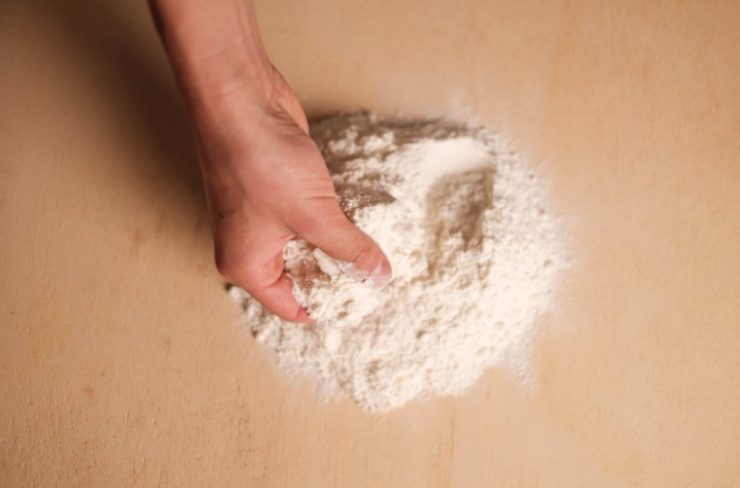All-purpose flour is one of the most commonly used flours, and it has a seemingly endless number of uses, hence the name.
Working as a pastry chef and baker, I had to understand how different flours work. And if you know the original function of the all-purpose flour in your recipe, it’s easier to choose the best substitute.
Flours containing gluten are pretty straightforward and prevent you from having to revamp your entire recipe. But if you’re heading into the gluten-free realm, you may need to make more changes.
No matter if you need a thickener, a base for baked goods, or pizza dough, I’ve got you covered with the 12 best all-purpose flour substitutes. With great gluten-free options to boot.
In This Article
All-Purpose Flour Substitutes (With Gluten)
1. Cake Flour or Pastry Flour
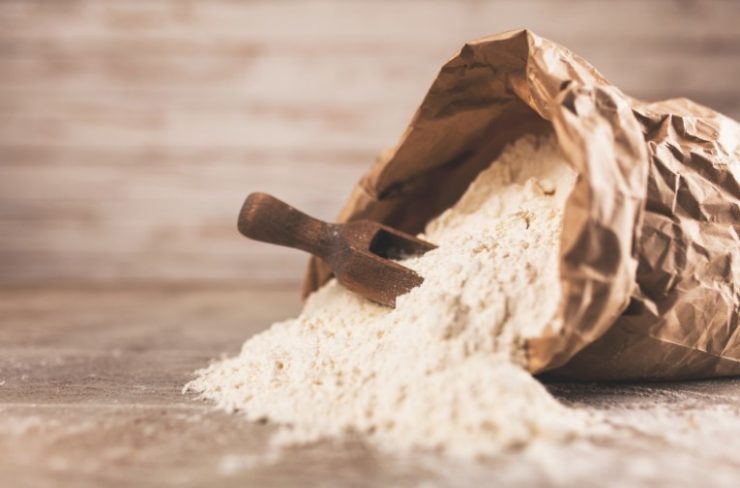
True to their name, these flours are best for cakes and pastries. However, they can also make extra-tender cookies and pie dough.
Keep in mind that this option is lower in gluten than all-purpose flour. This means that some items may turn out more tender or crumbly and less chewy than usual.
I’d avoid using cake or pastry flour in breads. These flours are too low in gluten to give the structural support that bread needs. Stick with bread flour for bread if you can.
For most recipes, you can substitute cake or pastry flour at a 1:1 ratio for all-purpose flour.

Pro Tip: Want a near-match in gluten content to all-purpose flour? Try a 50/50 mix of cake or pastry flour with bread flour.
2. Bread Flour
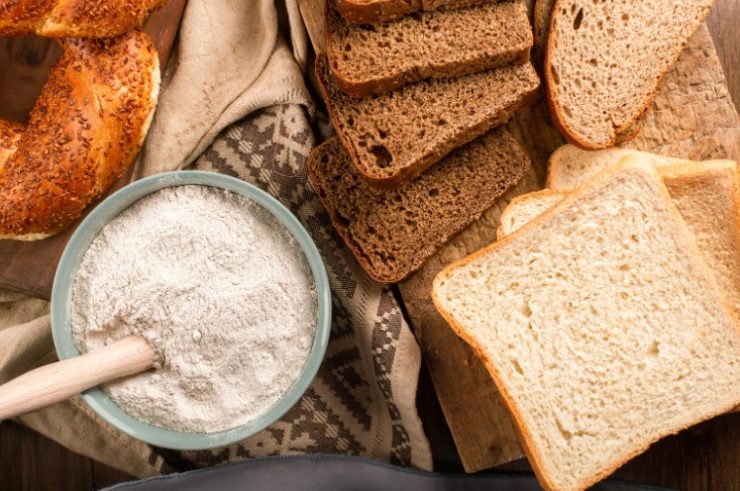
Bread flour is an ideal substitute for all-purpose flour in breads and pizza doughs. It’s also a reliable replacement in pancake recipes and some cookies.
One great thing about using bread flour for breads and pizza doughs is that it gives them great elasticity. This leaves a chewier texture after baking and a satisfying crispy crust.
Note that if you use bread flour in a pancake batter or cookie dough recipe, it’s important not to overmix. Since this flour is higher in gluten than all-purpose, it can cause toughness if overworked.
Substitute bread flour for all-purpose at a 1:1 ratio for bread and pizza doughs. For pancakes and cookies, you may want to lower the gluten content by using 50% bread flour and 50% pastry or cake flour.
3. Whole Wheat Flour
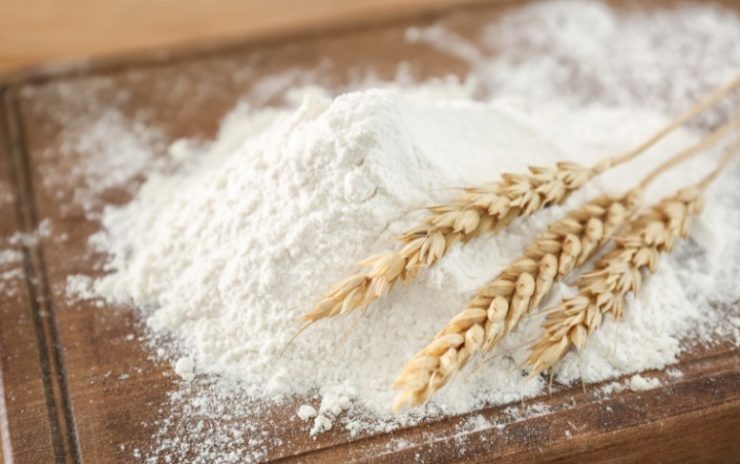
Whole wheat flour can serve as a hearty substitute in breads and many pastries and cookies.
Because whole wheat flour still contains the bran, it will affect the rise of your baked goods and breads. Consider this a worthy tradeoff for the flavor and nutrition boost.
In yeasted breads, replace all-purpose with 50% whole wheat flour and 50% of another white flour. That could be bread, cake, or pastry flour.
If you use 100% whole wheat, expect your bread to be quite flat and dense. But it will taste amazing. You’ll want to let whole wheat bread dough rest for 30 minutes to one hour after mixing for the flour to fully hydrate.
Try using about 10-15% less whole wheat flour for pastries, cookies, and pie doughs than you would all-purpose flour in your recipe.

Pro Tip: For yeasted breads, you’ll have an even better rise if you sift out the bran from your whole wheat flour before measuring.
4. Kamut Flour
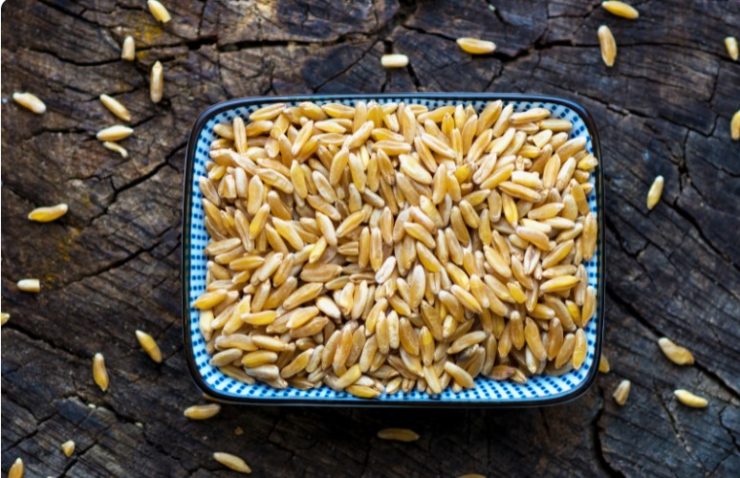
Kamut flour is a less common flour that makes amazing breads, cookies, and pastries. It can also make hearty pancakes and pastas. It really works well as an all-purpose flour substitute in almost anything.
Kamut is an “ancient grain” since it hasn’t been hybridized like the modern wheat in all-purpose flour. For this reason, it’s higher in nutrients and packed with flavor.
To use it in recipes, start with 10-15% less Kamut flour than you would all-purpose flour.
Gluten-Free All-Purpose Flour Substitutes
5. Oat Flour

Oat flour substitutes all-purpose flour splendidly in cakes, cookies, and pancakes. It’s also delicious in short doughs like tart shells, shortbread, and pie dough.
Oat flour’s well-rounded flavor leans slightly toward hearty, but it’s lighter than whole wheat. As a result, it works well as a 1:1 substitute in baked goods but isn’t ideal as a 1:1 substitute in breads, as it can get gummy.
While oats are technically gluten-free, they’re often processed on shared equipment with wheat flour. So if you need flour sans gluten, be sure to look for certified gluten-free oat flour.

Pro Tip: Don’t have any oat flour on hand at home? Whiz up whole oats in a food processor or blender to make oat flour on the spot.
6. Quinoa Flour

Quinoa flour is an ideal substitute for baking and thickening sauces and soups. It’s also great for battering and frying.
This high-protein, gluten-free flour is light and somewhat delicate. It can impart a bitter flavor and a somewhat gritty texture in large quantities. For this reason, it’s usually best when mixed with other flours.
For cakes and cookies, substitute quinoa flour for all-purpose flour at a 1:1 ratio. They will need to be recipes that already contain eggs or a similar binder and leavener combination.
Quinoa flour can also be mixed 50/50 with wheat-based bread, pastry, or cake flour. Try mixing it with other grains if you want to go gluten-free. Keep in mind that you’ll likely need to add starches and/or binders like xanthan gum.
As with most gluten-free flours, you’ll get the best results with a recipe made for this specific flour.
7. Almond Flour
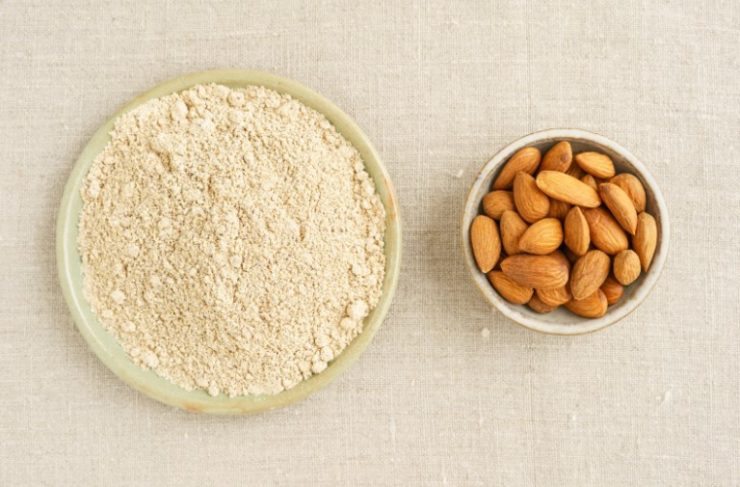
Almond flour can be substituted for all-purpose flour in cakes, short doughs, and cookies. It’s also a perfect thickener for curry and mole. Plus, I think it’s one of the tastiest of the gluten-free flours.
If you’ve ever tried an Italian almond cake, you know how scrumptious it can be! Almond flour does best in recipes with eggs for added structure and binding power.
Avoid using almond meal, which contains the nut’s skin, and start with almond flour, which is made from blanched almonds with the skin removed.
Try replacing all-purpose flour with almond flour at a 1:1 ratio. You will most likely need to use extra egg or egg whites in your recipe. Another option is to use a 50/50 blend of almond flour and white rice flour.

Pro Tip: Baked goods made with almond flour will brown and burn more easily. Try covering your items loosely with foil halfway through baking to protect their tops.
8. Buckwheat Flour
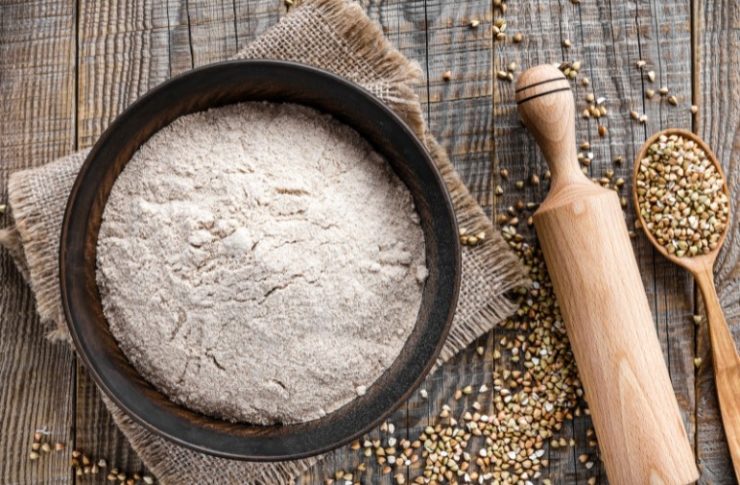
Buckwheat flour is an ideal replacement for crêpes, pancakes, and yeasted bread. This gluten-free wonder can also make delectable chocolate chip cookies.
Buckwheat crêpes are well-known in France and are amazing with either savory or sweet fillings. Crêpe batters can be made with 100% buckwheat flour instead of all-purpose flour.
Since buckwheat flour can be on the dry side, you may want to start with a 50/50 mix of buckwheat and wheat flour. In large quantities, it can make baked goods a little sandy in texture if there’s not enough moisture.
9. Chickpea Flour
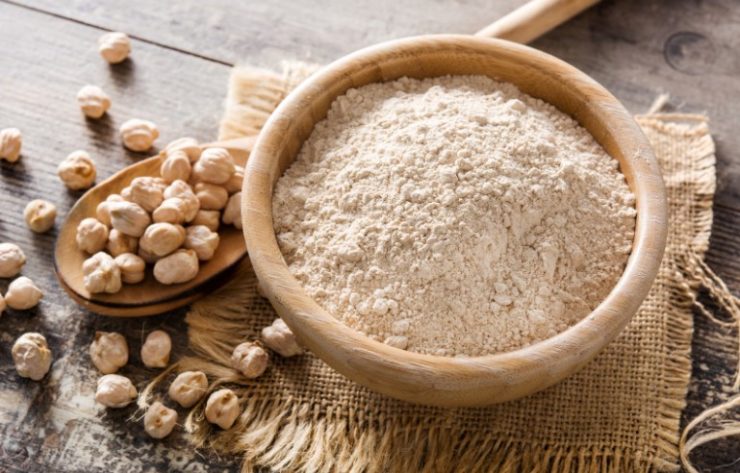
Chickpea flour, otherwise known as garbanzo flour, is a fabulous substitute for all-purpose flour. Use it in pizza crusts, flatbreads, crackers, fritters, and as a breading.
One bonus of chickpea flour is its high level of protein. Due to chickpea flour’s natural binding properties, chances are you won’t need to add any extra eggs either.
Once it’s soaked in water, chickpea flour can be used to make flatbreads. It can also serve as a batter for crispy vegetable fritters and breaded items. For these applications, use a 1:1 ratio to all-purpose flour.
Since chickpea flour can have a bitter taste, it’s not ideal as a 100% replacement for all-purpose flour in sweet items. So for baked goods like muffins, cookies, breads, and crepes, consider blending 50% chickpea flour with 50% white rice flour.
10. Cassava Flour
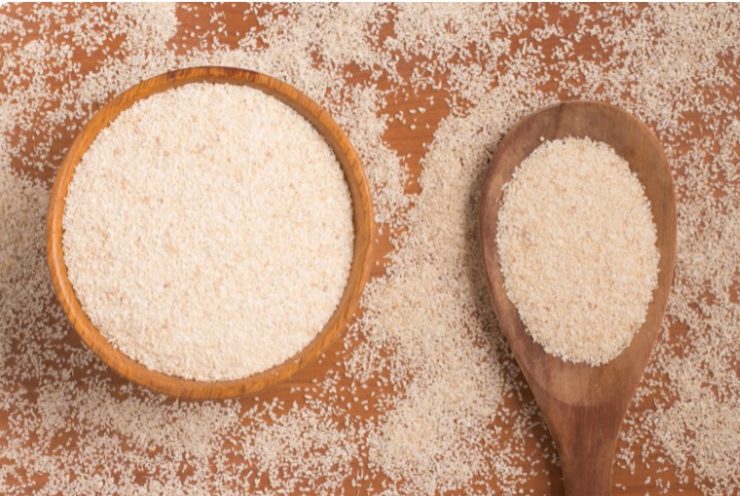
This paleo-friendly flour can replace all-purpose flour in tortillas, crackers, pancakes, crepes, and gnocchi.
Like most gluten-free options, cassava flour usually works best with eggs for binding purposes. It has a light, fine texture and can make flexible tortillas, crepes, and other flatbreads.
This flour may take some experimentation. Start by substituting ¾ cup cassava flour for every 1 cup of all-purpose flour. With this substitution, you may need to add extra liquid to your recipe and bake longer than usual.
And don’t be afraid to try this flour in pie dough and your favorite cookie recipes, either.
11. Rice Flours
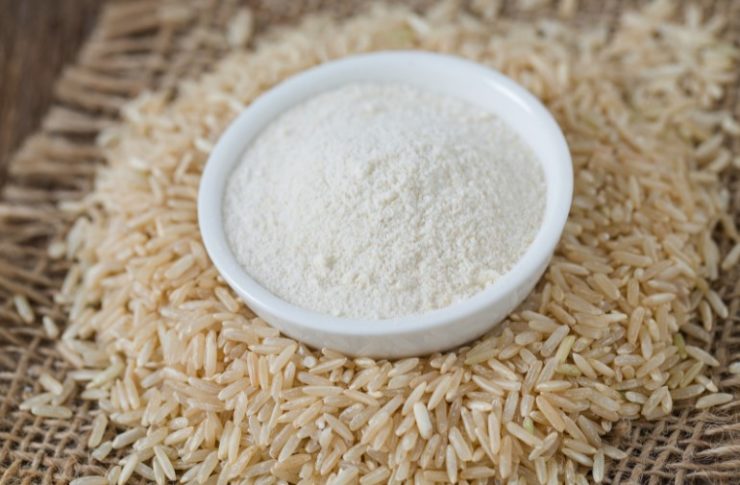
Rice flours are 100% gluten-free. Yet they cannot be used in baking as a direct, 1-to-1 substitute for all-purpose flour.
When baking with rice flour, your best bet is to look up a similar version of your recipe that already has rice flour in it. You’ll likely need to add other flours and ingredients like tapioca starch or xanthan gum.
There are 3 main types of rice flour, and they all have their ideal applications:
- White Rice Flour- Best used as a base flour to blend with other gluten-free flours. Works for baked goods, except for cookies and muffins. It can be used as a thickener, too.
- Brown Rice Flour- More nutritious than white rice flour, brown rice flour can also be used for baking. It’s excellent for breads and quick breads.
It’s higher in protein. And as a result, it tends to make baked goods brown more quickly.
If you can find it, try superfine brown rice flour for baking.
- Sweet Rice Flour- Also known as “glutinous” rice flour due to the texture of the “sticky” rice it’s made from. However, it doesn’t contain any gluten at all.
It’s my personal favorite for baking since it lends a pleasant, chewy texture to cakes and cookies.
Sweet rice flour is also perfect for thickening sauces and soups. Due to its sticky nature, this flour also works for breading meats and tofu.
12. Sorghum Flour
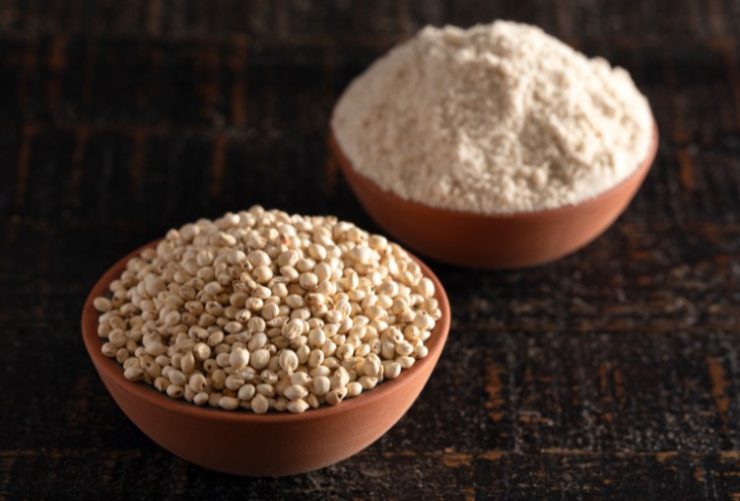
Sorghum flour has a similar taste and texture to all-purpose flour. It’s an ideal substitute in pancakes, crepes, muffins, and cookies. It can also be used as a base flour for gluten-free bread.
In pancakes, use a 1:1 ratio of sorghum flour to replace your all-purpose flour.
In other baked goods, go for a 50/50 ratio of sorghum flour to another wheat flour. Or you can experiment with creating a gluten-free blend.
Tips When Using Gluten-Free Substitutes
Gluten-free flours will likely take some experimentation to get the results you want. You can save time by using a similar recipe that contains the gluten-free flour you’d like to use.
Gluten-free flours lack the stretchy, structure-providing proteins of gluten. So they usually need a blend of several flours. These blends may also include starches like potato, tapioca, or cornstarch.
Many recipes with gluten-free flours also call for xanthan gum or guar gum. These act as binders and provide some elasticity.
Most gluten-free flours are also less absorbant than wheat-based flours. Because of this, it can be helpful to mix them longer. Chickpea flour, in particular, benefits from sitting out for an hour or so after mixing.
Have you used a gluten-free substitute, and it feels too dry after mixing? Feel free to add extra moisture or another egg. One bonus of using gluten-free flours is that you don’t have to worry about overmixing.
Frequently Asked Questions
What’s the best substitute for all-purpose flour in a roux?
Sweet rice flour is the best 1:1 substitute for all-purpose flour in a roux. It’s light in texture and has a great thickening ability and taste.
What’s the best substitute for all-purpose flour in cookies?
Pastry flour is the best substitute for all-purpose flour in cookies. It has a slightly lower gluten content that works well in cookie recipes.
How can I substitute all-purpose flour in pizza dough?
Use a 1:1 ratio of bread flour to replace all-purpose flour for pizza dough recipes. This will give a chewy texture and a crispy crust.
